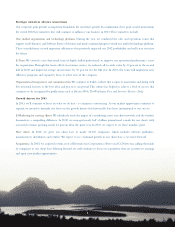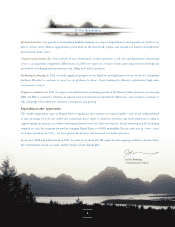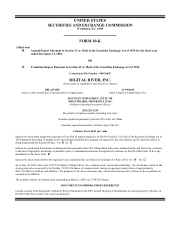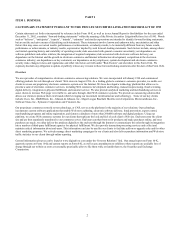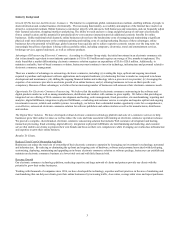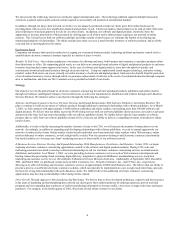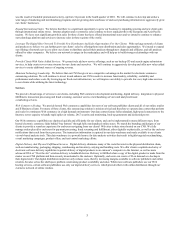Digital River 2002 Annual Report Download - page 15
Download and view the complete annual report
Please find page 15 of the 2002 Digital River annual report below. You can navigate through the pages in the report by either clicking on the pages listed below, or by using the keyword search tool below to find specific information within the annual report.9
Product Research and Development
Our product research and development strategy is to enhance the technology and features of our CNS. To this end, we have numerous
development projects in process, including deployment of version 4 of our CNS technology, further advancements in our remote control
technologies, business-to-business related technologies and advanced product distribution and marketing technologies. Product research and
development expenses were $11.5 million, $11.2 million and $13.1 million in 2002, 2001 and 2000, respectively. As of March 1, 2003, we
employed 99 persons in product research and development.
To remain competitive, we must continue to enhance and improve the responsiveness, functionality and features of the CNS and the underlying
network infrastructure. If we incur significant costs without adequate results, or are unable to adapt rapidly to technological changes, we may
fail to achieve our business plan. The Internet and the electronic commerce industry are characterized by rapid technological change, changes in
user and client requirements and preferences, frequent new product and service introductions embodying new technologies and the emergence
of new industry standards and practices that could render our technology and systems obsolete. To be successful, we must adapt to rapid
technological change by licensing and internally developing leading technologies to enhance our existing services, developing new products,
services and technologies that address the increasingly sophisticated and varied needs of our clients, and responding to technological advances
and emerging industry standards and practices on a cost-effective and timely basis. The development of our CNS technology and other
proprietary technologies involves significant technical and business risks. We may fail to use new technologies effectively or fail to adapt our
proprietary technologies and systems to client requirements or emerging industry standards.
Competition
The market for Internet-based, electronic commerce solutions is extremely competitive and we may find ourselves unable to compete
effectively. Because there are relatively low barriers to entry in the electronic commerce market, we expect competition to intensify as current
competitors expand their product offerings and new competitors enter the market. In addition, our clients may become competitors in the future.
Increased competition is likely to result in price reductions, lower average sales prices, reduced margins, longer sales cycles and a decrease or
loss of our market share, any of which could negatively impact our revenues and earnings. We face competition from the following sources:
• in-house development of electronic commerce capabilities;
• other providers of outsourced electronic commerce solutions;
• software publishers and online retailers who have or may choose to make substantial initial and ongoing investments in order to
develop and manage their own electronic commerce sites, and who may decide to market this capability to other companies;
• system integrators and application service providers that offer tools and services for electronic commerce, including companies that
provide a broad range of Internet and server solutions, such as Corio, Inc., Electronic Data Systems Corporation and IBM Global
Services;
• companies that provide tools and services enabling one or more of the transaction processing functions of electronic commerce, such
as transaction control, data security, customer interaction and database marketing, including BroadVision, Inc. and CyberSource
Corporation;
• companies that sell, distribute or rent software products over the Internet;
• high-traffic, branded Web sites that derive a substantial portion of their revenues from electronic commerce and may themselves offer,
or provide means for others to offer, software products, such as Amazon.com, Inc. and GSI Commerce, Inc.; and
• traditional channels and methods of retail and corporate software sales, such as mail order catalogs and retail superstores.
We believe that the principal competitive factors in our market are breadth of services and software product offerings, software publisher and
online retailer relationships, brand recognition, system reliability and scalability, price, customer service, speed and accessibility and ease of use,
speed to market, convenience and quality of fulfillment. The online retailers and the other companies described above may compete directly
with us by adopting a similar business model. Moreover, while some of these companies are also clients or potential clients of ours, they may
compete with our electronic commerce outsourcing solution to the extent that they develop electronic commerce systems or acquire such
systems from other software vendors or service providers.


